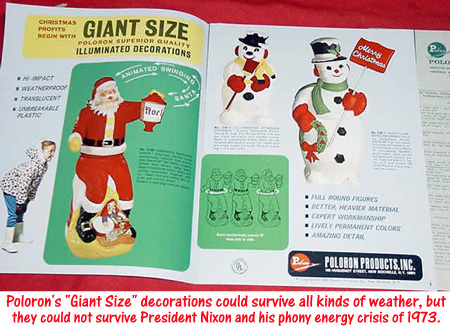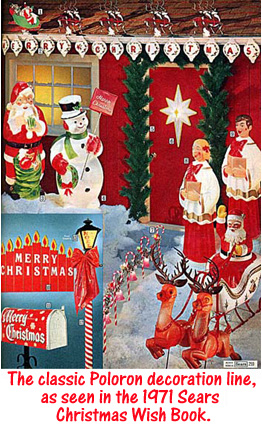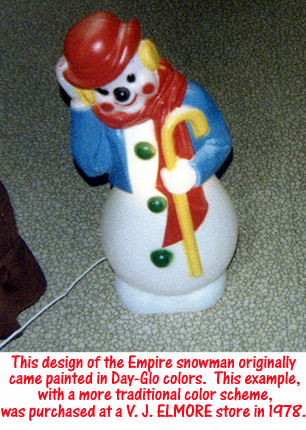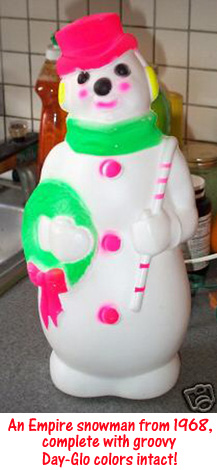By TIM HOLLIS In the other part of our special feature, we revisited those glory days of Christmas in downtown Birmingham. However, for most of us, the holiday season was centered just as much around the neighborhoods in which we lived. Countless former kids remember the excitement of riding around with their parents to see all the different houses and their various displays of lights and decorations. Of course, this is one tradition that can continue to this day -- but in this era of mass marketing and ubiquitous retailers such as Wal-Mart, it is far more likely that today's decorated houses and lawns will look a whole lot alike, with many of the same decorations appearing over and over again. During the period we here at BIRMINGHAM REWOUND think of as our childhood, outdoor decorating tended to be considerably more individualized. Granted, much of what follows is going to be related from an intensely personal standpoint by the author (that's me, folks), but it should strike a responsive chord in just about anyone who is past thirty years old, and if you happen to be in your forties -- well, just get out the Kleenex and be ready to shed a few nostalgic tears. Strings of Christmas lights had been advertised for both indoor and outdoor use at least since the early 1930s -- and maybe even longer than that -- but lavish outdoor Christmas displays were basically a post-World War II innovation. This is probably due in no small part to the combined one-two punch of the baby boom and increased postwar prosperity. By 1965, the tradition was so firmly established that it was able to be spoofed in A Charlie Brown Christmas, with good ol' Chuck dismayed to learn that his own dog has won first prize in a neighborhood decoration contest. So, let's take one aspect of this lawn decorating business and try to trace it through the years: the ever-popular rendering of Santa Claus with his sleigh and reindeer.
One of the first attempts to market a setup of this type for home use involved more than a little of the "do it yourself" mentality so prevalent in the 1950s. Outlets such as hardware stores would sell sheets of vinyl that were preprinted with remarkably lifelike and detailed artwork depicting jolly old St. Nick and his flying quadrupeds; would-be exterior decorators were required to mount these shapes on a wooden backing and then painstakingly cut them out with a band saw or some similar instrument. When done well and illuminated with floodlights, such a scene could be most memorable. In fact, many other Christmas staples were also produced in this manner, including angelic carolers and Nativity scenes (which were also marketed already mounted on backings, saving a lot of work).
The next evolution was to manufacture flat sleigh-and-deer sets out of plastic. These were infinitely smaller than the preprinted vinyl variety -- the deer stood less than two feet tall, and were illuminated by "footlights." These were literally white bulbs at the feet of each deer and the runners of the sleigh, with aluminum foil reflectors that were supposed to direct the light upward. From more than ten feet away, this style of scene looked like nothing but a row of white lights. Sears was marketing these "flat deer" sets in its catalog at least as early as 1963, but many of them were sold through the legendary Spencer Gifts catalogs later in the decade. While Sears had the decency to describe them accurately, the copywriters at Spencer should have had noses that resembled Pinocchio by the time they got through concocting their hype. The Spencer description blatantly described the sleigh and deer as "all lit up in 3-dimension," and otherwise indicated that the whole outfit would make a traffic-stopping display on any front lawn. That might have been true had they elaborated that the only way for people to view it would be to stop their cars, get out, and walk across the lawn until they were directly in front of it. We now introduce a company name that would have much influence on Christmas decorations for a decade. The Poloron Corporation of New Rochelle, New York had its icy fingers in a number of different products, including thermos jugs and coolers. In the early 1960s, Poloron began diversifying into lighted outdoor decorations with assorted holiday figures, and in 1967 made its first attempt at bringing Santa and his antlered friends to life.
The deer were not the first, and far from the only, Christmas figures produced by Poloron. The company's wares first showed up in the 1965 Sears Christmas catalog, with a short and squat snowman. When I was growing up, there was only one house in our neighborhood with one of these original Poloron snowmen -- remember, as I said in the beginning, not every house had the same thing, as they often do today -- and I know that the snowman's large black nose and red earmuffs protruding from underneath his hat made me think that he was supposed to be a dog instead. Check the photo here and judge for yourself, Rover. Poloron improved its quality over the years, and by the late 1960s had enough different figures to fill an entire page of the Sears catalog by itself. The company struck Christmas gold with its king-size Santa and snowman figures that stood four feet tall; the Santa was the most commonly seen of the two, holding a present in one hand and putting his finger to his lips with the other, in a "shushing" pose. Poloron also produced a line of four-foot-tall carolers that today command outrageous prices on eBay, probably because fewer people bought them than Santas and snowmen.
Poloron soon got really carried away and made even larger Santa and snowman figures that contained interior motors to make them swing back and forth at the waist. Not forgetting the real meaning of Christmas, Poloron marketed two different sizes of lighted Nativity scenes. Poloron's Christmas line was decimated in 1973, when then-President Nixon decreed that people should stop decorating their yards in order to cut down on energy usage. Since the Poloron figures generally utilized 60-or-75-watt bulbs each, the company found it impossible to survive this decree from on high. The various pieces were gradually discontinued, with at least the remaining stock of Nativity scenes hanging on until 1977 or so. In the years since Poloron's downfall, various other companies have apparently purchased the molds and produced their own, cheaper versions for mass consumption. The four-foot Poloron snowman turned up in this form a few years back, and versions of the smaller Nativity set can still be found at Wal-Mart to this day. Poloron's most enthusiastic competitor was Empire, a conglomerate that was also involved in the manufacturing of toys and many other synthetic products. Empire's Christmas line included a large number of small lighted figures intended for indoor use, but often featured large versions of the same ones for the lawn. Empire had its own four-foot snowman, plus a smaller version bedecked in a blue tailcoat and red derby. (For a while, both the Poloron and Empire figures were painted using fluorescent Day-Glo colors, which looked great when new but did not hold up well after years of weathering.)
Empire managed to keep going for several years after Poloron bit the snowbank, but it too eventually succumbed to higher energy costs. There were other companies responsible for outdoor decorations, but not quite to the extent of the above two. The Beco company had its own line of carolers and deer, as mentioned earlier, some of which were lighted while others were not.
Of course, it should go without saying that much of the type of outdoor decorating described above has now been replaced with the ever-popular figures that are simply outlined in lights rather than being 3-D statues. Large Christmas shops can provide these in a seemingly infinite variety of shapes and styles, and many of them make use of the same animation technology that enabled the fondly-remembered neon signs of our youth to operate; multiple arms that light in stages to make Santa Claus wave, and so forth. Will these be the fond childhood memories of today's kids 40 years from now? Maybe so, but one way to ensure that is to bundle up your spouse and younguns and head out into the neighborhoods to see them. Be sure to stick a CD of Christmas music in your car's player while you do so, and everyone sing along. You may find that while times and styles change, there is no time limit on having a MERRY CHRISTMAS! Do you have vintage 1960s/1970s
photos of your own yard, or anyone else's, in the Birmingham area decorated
for Christmas? E-mail them to Tim
at birminghamrewound dot com!
RETURN TO MENU RETURN TO CHRISTMAS PAST IN DOWNTOWN BIRMINGHAM This page last updated 07/09/2006 -- 252 PM EDT |
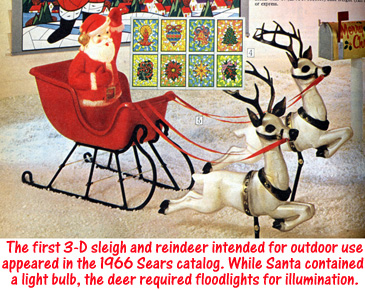 In
reality, the original 3-D sleigh/deer design was made by another company,
Beco,
and hearkened back to what had been done before, in that the figures were
not lighted, and required a floodlight to illuminate them. On the
plus side, they were fully rounded and molded in plastic, so for the first
time they did actually appear in 3-D (Spencer Gifts's earlier claims notwithstanding).
These must have drawn some attention during their first year, because for
the very next Christmas season, Poloron introduced a new and improved model.
Now the sleigh and deer were lighted from within -- 60-watt bulbs in both
the sleigh itself and Santa's body, and two 7-watt bulbs in each deer --
and now the scene really could take on impressive scale. Some people
chose to stick with the two deer that came as standard equipment, but others
splurged and made sure the proper number of eight were on hand. (Since
companies such as Poloron were not licensed to market copyrighted characters
such as Rudolph, many enterprising decorators
In
reality, the original 3-D sleigh/deer design was made by another company,
Beco,
and hearkened back to what had been done before, in that the figures were
not lighted, and required a floodlight to illuminate them. On the
plus side, they were fully rounded and molded in plastic, so for the first
time they did actually appear in 3-D (Spencer Gifts's earlier claims notwithstanding).
These must have drawn some attention during their first year, because for
the very next Christmas season, Poloron introduced a new and improved model.
Now the sleigh and deer were lighted from within -- 60-watt bulbs in both
the sleigh itself and Santa's body, and two 7-watt bulbs in each deer --
and now the scene really could take on impressive scale. Some people
chose to stick with the two deer that came as standard equipment, but others
splurged and made sure the proper number of eight were on hand. (Since
companies such as Poloron were not licensed to market copyrighted characters
such as Rudolph, many enterprising decorators
